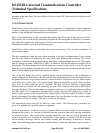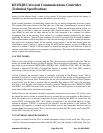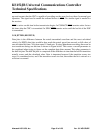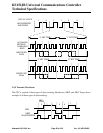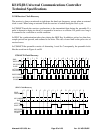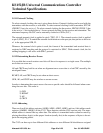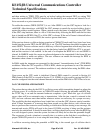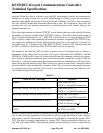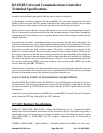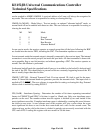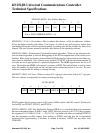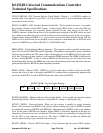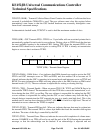
KS152JB Universal Communications Controller
Technical Specifications
Kawasaki LSI USA, Inc. Page 67 of 120 Ver. 0.9 KS152JB2
expected. When this type of collision occurs the GSC automatically handles the retransmission
attempts for as many as eight tries. If on the eighth attempt a collision occurs, the transmitter is
disabled, although the jam and back off are performed. If enabled, the CPU is then interrupted.
The user software should then determine what action to take. The possibilities range from just
reporting the error and aborting transmission to reinitializing the serial channel registers and
attempt retransmission.
If less than eight attempts are desired TCDCNT can be loaded with some value which will reduce
the number of collisions possible before TCDCNT overflows. The value loaded should consist of
all 1s as the least significant bits, e.g. 7, 0FH, 3FH. A solid block of 1s is suggested because TCD-
CNT is used as a mask when generating the random slot number assignment. The TCDCNT reg-
ister operates by shifting the contents one bit position to the left as each collision is detected. As
each shift occurs a 1 is loaded into the LSB. When TCDCNT overflows, GSC operation stops and
the CPU is notified by the setting of the TCDT bit which can flag an interrupt.
The amount of time that the GSC has before it must be ready to retransmit after a collision is
determined by the mode which is selected. The mode is determined M0 (GMOD.5) and M1
(GMOD.6). If M0 and M1 equal 0,0 (normal backoff) then the minimum period before retrans-
mission will be either the interframe space or the backoff period, whichever is longer. If M0 and
M1 equal 1,1 (alternate backoff) then the minimum period before retransmission will be the inter-
frame space plus the backoff period. Both of these are shown in table below. Alternate backoff
must be enabled if using deterministic resolution. If the GSC is not ready to retransmit by the time
its assigned slot becomes available, the slot time is lost and the station must wait until the colli-
sion resolution time period has passed.
Instead of waiting for the collision resolution to pass, the transmission could be aborted. The deci-
sion to abort is usually dependent on the number of stations on the link and how many collisions
have already occurred. The number of collisions can be obtained by examining the register, TCD-
CNT. The abort is normally implemented by clearing TEN. The new transmission begins by set-
ting TEN and loading TFIFO. The minimum amount of time available to initiate a retransmission
Table 13:
What the GSC was doing Response
nothing None, Unless DCR =1.
If DCR = 1, begin DCR countdown
Receiving a Frame, first byte not in RFIFO yet. None, unless DCR = 1.
If DCR = 1, begin DCR countdown.
Receiving a Frame, first byte already in RFIFO. Set RCABT, clear GREN.
If DCR = 1, begin DCR countdown.
Transmitting a Frame, first byte still in TFIFO Execute jam/backoff.
Restart if collision count
< 8.
Transmitting a Frame, first byte already taken from
TFIFO
Execute jam/backoff.
Set TCDT, clear TEN.



